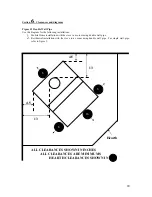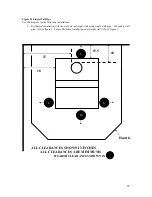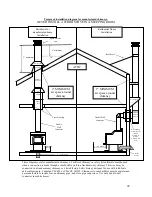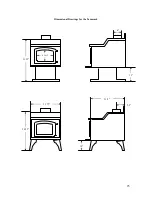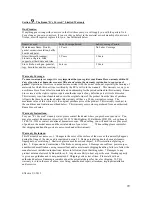
17
Glass cleaning and replacement – as needed
1.
Never clean the glass when it is hot.
2.
Clean the glass with an approved stove glass cleaner, never use an abrasive material like
sandpaper or steel wool
3.
Your stove is equipped with an air wash system that will self-clean the glass. If the glass is black
or covered with soot from slow burning, simply load the stove with good, dry, split wood and burn
at high burn for about 20- 30 minutes and the glass should burn clean.
4.
Never build a fire against the glass.
5.
When closing the door be sure that no pieces of wood are protruding from the door opening that
could touch the glass. Excessive stress like closing the door on a piece of wood will break the
glass. If the glass ever breaks in your stove, don’t panic, simply shut the air off and let the fire
burn out. Do not continue to operate a stove with broken glass. Do not leave the stove unattended
with broken glass.
6.
To replace the glass it may be helpful to remove the door from the stove and place on a clean soft
work area. Remove the retaining ring screws and retaining ring, remove the glass and dispose of
properly, CAUTION: BROKEN GLASS WILL BE SHARP. Clean the door thoroughly where
the new piece of glass will install. Set the new piece of glass into the door and replace the
retaining ring and screws. Be careful to tighten the screws evenly, uneven pressure can break the
glass. Tighten the screws just enough to hold the glass firmly, over tightening can cause uneven
pressure and can break the glass.
Brick replacement – As needed
1.
Bricks should be inspected and replaced if necessary at least once a year. Cracked bricks are fine
as long as they remain in place. Some of the bricks inside your stove are interchangeable, so
shuffling bricks around can be done, for example, a baffle brick that is broken and will not stay in
place can be swapped with a brick on the firebox bottom.
Clean and inspect stove – Every year
1.
Your stove should be fully cleaned and inspected once a year. This is a great time to inspect the
bricks, gaskets, ceramic blanket and the rest of the stove for signs of abnormal wear. Start by
shoveling all the ashes out of the stove and emptying the ash pan. Use a shop vac to clean the
hard to reach places. Look at the inside of the stove for signs of wear, paying close attention to the
stainless steel baffle brick holders and burn tubes. Discoloration of the stainless steel is normal as
is slight sagging. If either of the brick holders is failing to keep the bricks in place then it should
be replaced.
Replace ceramic insulation – Every year or as needed
1.
At least once a year, check the ceramic insulation on top of the baffle in your stove. The ceramic
insulation is designed to keep heat in the stove and increase efficiency. As long as the insulation
is in place it can be left alone. If the insulation becomes torn during cleaning, simply lay it back
together tightly in that area. If the insulation tears to multiple pieces, it should be replaced,
smaller pieces can become caught in the draft and cause a restriction.


















